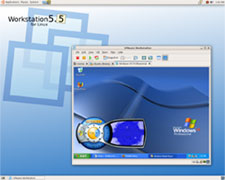AMD Athlon 64 FX-62 And X2 5000+ Socket AM2, nForce 590 SLI & ATI RD580
DDR2 Memory Controller And Hardware Virtualization

In addition to the increased memory bandwidth that DDR2 technology brings to the AM2 platform, AMD had to make accommodations in its memory controller that render the processor a little less flexible versus legacy socket 939 equivalents, when it comes to overclocking and the like. However, AMD did design in a critical new feature to the core that should offer increased performance for those running multiple virtual operating systems.
|
|
|
AMD's New DDR2 Memory Controller And A Change In Timing Ratios:
The AM2's new DDR2 memory controller no longer supports half multiples. For example an Athlon 64 FX-62, clocked at 2800MHz uses a 200MHz base frequency and a 14X core multiplier, along with a X7 divisor (2800/7), to drive 400MHz for Memory Interface speed of DDR2-800. Similarly, for the Athlon 64 X2 5000+'s 2600MHz clock, the processor must divide by a whole number to get close to, but not go over 400MHz, which translates to 2600/7 or 371MHz, which is then clock-doubled for DDR2 and yields a 742MHz memory speed, even though a system BIOS may be set for "DDR2-800" speeds.
These new ratios are a bit confusing, so we've put together a chart to show you what the memory divisors are, depending on the CPU multiplier used.
| CPU Multiplier | Stock Processor Speed | Memory Divisor | Net DDR-2 Input Clock - "DDR2-800" Settings |
| 10X | 2000MHz | /5 | 400MHz |
| 11X | 2200MHz | /6 | 366MHz |
| 12X | 2400MHz | /6 | 400MHz |
| 13X | 2600MHz | /7 | 371MHz |
| 14X | 2800MHz | /7 | 400MHz |
|
15X* |
3000MHz* | /8* | 375MHz |
* Theoretical processor speed, not yet announced
Hardware Virtualization Support:
The new AM2 Athlon 64's revised core will provide support in hardware for virtualization, which allows the processor to manage multiple operating systems at one time with a thin executive software layer required to provide access to critical system resources. This support will offer significant performance benefits versus traditional emulation-only methods, since it will allow for a much tighter coupling of processor resources to each instance of OS running on a system.

Image courtesy, VMware Inc.
The reason running multiple OSes on a PC, with the secondary or tertiary OS running in full emulation mode, is so slow is because the hardware for the virtual OS is emulated in software. Off-loading the management of this function to a dedicated hardware resource, should by all rights offer large gains in performance. AMD's Virtualization technology offers an instruction set and dedicated CPU core hardware resources for handling things like I/O calls and interrupts.
This could be a welcome addition for Linux users interested in stronger virtual Windows performance for legacy Windows applications. In addition it goes almost without saying that this eventually could well be a required checklist feature because Intel's processors have had this feature for quite sometime. The age of the dual core CPU and Intel's HyperThreading technology have paved the way for more powerful virtualization functionality and it has great promise for the future, especially in Enterprise IT and the Professional Workstation markets.






